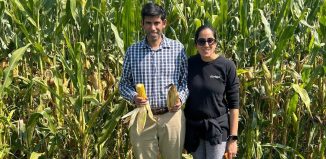CSHL’s Albeanu sniffs out the mouse neurons in smell
Mice rely on their sense of smell for their survival, sniffing out food, finding mates, or scampering away from the butcher’s wife or, more likely, a hungry fox.
Dinu Florin Albeanu wants to understand how the scents in the air translate into signals in a mouse’s brain that cause the animal to understand its environment and react accordingly.
An assistant professor at Cold Spring Harbor Laboratory, Albeanu studies the neurological circuits in mouse brains, trying to figure out how information translates into behavior.He is attempting to understand how the mouse decides what aspects are important and what are not important.Albeanu is excited to ask these kinds of scientific questions at a time when the technology to monitor individual neurons on a real-time basis has taken such enormous strides in recent years.
He is able, for example, to take a thirsty mouse that has smells coming from its right and left. If the mouse licks a port on the left in response to a specific signal, it gets water. While the mouse is considering the smells around it, Albeanu and his colleagues can monitor the specific activity in the brain to see how it is changing.
To check to see how important any neurons are in perception, the CSHL research team can suppress activity in those circuits and see if the mouse reacts to the smell in a different way. The scientists turn off different subsets of neurons, so they can ask “at what point is smell A perceived as something different,” Albeanu said.
Going further than this, Albeanu looks at how altering specific features of activity, such as the timing of when neurons spike or the number of spikes, can alter the circuit and, eventually, the behavior of the animal.
The animals have a neurological feedback loop, where the cortex sends signals back to the olfactory, or smell, area. In one experiment, Albeanu’s crew is monitoring the information from those signals. By doing so, he can determine whether the feedback ensures that there is not an error signal, where the initial reaction to a scent requires reinforcement with additional odor gathering before reacting. He performs similar experiments with the feedback loop, suppressing some of the returning neurological information to determine its role in generating behavior.
In his broad range of research, Albeanu is also interested in how mice process olfactory stimuli with visual information or other types of sensory cues. Would a mouse sooner trust what it sees, if there’s an image of a predator nearby, or what it smells, if that image includes the scent of food or a mate?
“The brain extracts and processes information about the environment combining multiple senses,” he explained. “We’re probing how and where in the brain visual and olfactory cues are compared and integrated, and indeed pursuing a range of experiments along these lines.”
Vivek Jayaraman, a group leader at Janelia Farm Research Campus of the Howard Hughes Medical Institute, called Albeanu “technically gifted and resourceful.” He suggested that the CSHL scientist, whom he’s known for a decade, uses “a powerful combination of techniques to record and stimulate neural activity and, importantly, they’re also busy adding interesting animal behavior tasks to the mix. This makes for a pretty potent cocktail.”
Albeanu, who said he himself has probably an average sense of smell, explained that he is “fascinated by how little is known about how you go from the smells to complex perceptions.”
A resident of Huntington, Albeanu has been at CSHL since 2008. He also rents an apartment in the city. While he’s on the Island, he enjoys running, biking and swimming.
Albeanu spends about a month each year in his native Romania to co-organize a summer course called Transylvanian Experimental Neuroscience Summer School. This past June, the second summer for the course, organizers received applicants from 37 countries.
The course focuses on experimental and theoretical methods to study how the brain operates at the level of neuronal circuits.Albeanu describes his work as basic research, in which he asks questions and seeks answers to understand the way systems like olfaction can generate behavior. He can imagine an extension of this work, in which future research could get at how the human brain operates.






